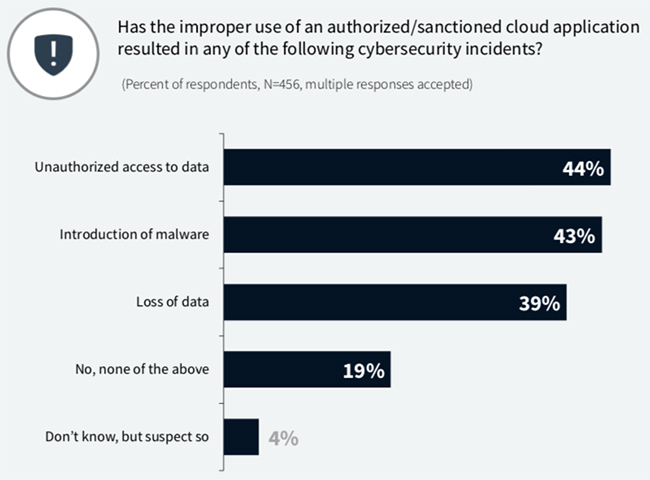Cloud services serve core functions essential to all aspects of business operations, but getting cloud security right is still a challenge for many organizations, the 2019 Cloud Threat Report by Oracle and KPMG has shown.
The two companies have asked 450 cyber security and IT professionals from private and public-sector organizations in the US, Canada, UK, Australia and Singapore about the problems surrounding cloud adoption and use in their environments.
While 73 percent of them feel the public cloud is more secure than what they can deliver in their own data center, there are still many sore points that negatively impact their organization’s security posture:
- The continuing confusion around the shared responsibility security model
- The visibility gap
- The risks that come with an increasingly mobile workforce using cloud-delivered applications
- The unabated threat of shadow IT.
Lack of visibility and clarity about the security responsibility
Cloud services are becoming the primary data store for many organizations, but when asked which percentage of the company’s data is currently stored in the public cloud, surveyed CISOs and CIOs offered divergent answers.
“This disparity (…) is troublesome as it indicates a lack of awareness and involvement in the use of cloud services by one of the organizational leaders responsible for securing that usage,” Oracle and KPMG point out.
CISOs are, unfortunately, too often on the cloud security sidelines. “The decentralized adoption of cloud services by line of business leaders who do not follow approval methodologies creates a visibility gap for the organization’s cybersecurity leaders,” the results indicate.
82 percent of cloud users have experienced security events due to confusion over the shared responsibility model. What’s more, only 10% of the polled CISOs fully understand the shared responsibility security model, compared with 25% of CIOs who report no confusion.

The lack of visibility is also a great problem:
- A third of the respondents say that they have difficulties when it comes to detecting and reacting to security incidents in the cloud
- 29% struggle with a lack of skills and qualified staff (especially when it comes to cybersecurity)
- 24% struggle with a lack of visibility across their data center and endpoint attack surface.
Shadow IT and insecure cloud access
The respondents have witnessed unsanctioned/shadow IT cloud applications resulting in unauthorized access to data (50%), introduction of malware (48%) and loss of data (47%), and are justifiably worried about it.
Improper use of sanctioned cloud applications is also a problem:

While 91 percent of the organizations have formal methodologies around cloud usage, 71 percent of the respondents are sure these policies are being violated by employees.
“When it comes to who has access to cloud-resident sensitive data, there are many users, including business partners, contractors, supply chain partners, auditors, part-time employees, customers, and others. These individuals will use different devices and operate under different policies and norms than an organization’s full-time employees, putting cloud-resident data at risk,” Oracle and KPMG also noted.
“At the center of how the use of cloud services has increased the risk associated with third-party access are enterprise file sync and share services (EFSS). EFSS services are often used by employees to share corporate data not only with each other but as a means to easily collaborate with external partners. Because EFSS tools are one of the most common types of shadow IT applications, their use, including with whom data is being shared, is often not governed, creating additional risk for the business.”
Fixing the problems
43% of the pollees say that they have implemented automated patch management and 46% expect to implement it in the next 12-24 months. They are primarily interested in gaining greater operational efficiencies (48%), but also reducing the window in which vulnerabilities can be exploited (29%).
57% of businesses are actively evaluating replacing passwords or planning to in the next 12-24 months. 6% have already eliminated them in favor of other forms of authentication (SMS, YubiKey smart card, fingerprint, token, etc.)
28% of the organizations already use multi-factor authentication to authenticate access to a wide variety of systems and data assets, 46% use it for access to their most mission critical resources, sensitive data, and use of root/admin accounts, and 18% are in the process of implementing it in the next 18 months.
To protect the expanded perimeter of the enterprise companies have taken a variety of actions, but those that had the most positive impact are those that reduce the attack surface: more regular penetration testing, more frequent patching and automated exploitation protection. When it comes to edge-based control, web application firewalls (WAF), cloud access security brokers (CASBs), and botnet/DDoS mitigation controls are deemed to be critical or very important.
Finally, the percentage of organizations who deployed or plan to deploy machine learning technologies to meet security challenges has risen by 6%.
They hope it will help them investigate more security alerts (29%), reduce false positives (26%), eliminate other more compute-intensive detection techniques (25%), detect “zero-day” threats (25%), and handle more incidents with Tier 1 analysts.
Source: helpnetsecurity.com


